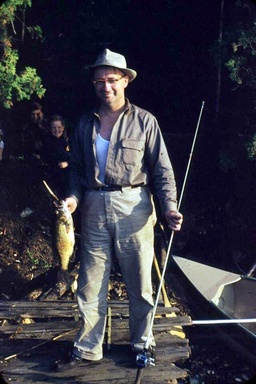 John W. Gorgas, submitted by an anonymous contributor.
John W. Gorgas, submitted by an anonymous contributor.  John W. Gorgas, submitted by one of his grandsons, Chris Gorgas. Born: October 16, 1903
John W. Gorgas, submitted by one of his grandsons, Chris Gorgas. Born: October 16, 1903
Died: August 7, 1994
Married: Margaret Knapp, June 14th, 1930 in her family's home in Elsmere, New York
Children: Richard K. Gorgas, John "Jack" Gorgas, David Gorgas, James Gorgas
John W. Gorgas was a switching engineer for Bell Telephone. He held Tent Platform Permit No. 1197 in Pope Bay on Lower Saranac Lake.
 Grandpa and trout
Grandpa and trout Grandparents and Aunt RuthHe was born in Kenilworth, New Jersey and grew up in Newark and East Orange. As a boy he visited Thomas Edison on numerous occasions, and over time was influenced to become an inventor. He was employed by Bell Telephone, beginning as a pole climber, and eventually moved into management as a switching engineer. He studied engineering for two years at Drexel, but left before completing a full degree. He worked on the Manhattan Project. Over time, he acquired over 100 patents, all of which were signed over to Bell Labs for a dollar each. He invented the switch used for conference calling. He was "loaned" to AT&T to head the development of the Autovon Switching project for the US Air Force. The resulting Polygrid system was the forerunner of the internet. 1
Grandparents and Aunt RuthHe was born in Kenilworth, New Jersey and grew up in Newark and East Orange. As a boy he visited Thomas Edison on numerous occasions, and over time was influenced to become an inventor. He was employed by Bell Telephone, beginning as a pole climber, and eventually moved into management as a switching engineer. He studied engineering for two years at Drexel, but left before completing a full degree. He worked on the Manhattan Project. Over time, he acquired over 100 patents, all of which were signed over to Bell Labs for a dollar each. He invented the switch used for conference calling. He was "loaned" to AT&T to head the development of the Autovon Switching project for the US Air Force. The resulting Polygrid system was the forerunner of the internet. 1
He first came to Saranac Lake on a canoe trip, then began camping on Turtle Point on Middle Saranac Lake. Eventually, he secured a permit to build a tent platform on Lower Saranac Lake. Although he traveled extensively around the US and Europe, he loved his camp, and some years spent from Memorial Day to Columbus Day weekend there. Not only his grandchildren, but many of their friends kept him and my grandmother company throughout the summer. A devout Christian, every breakfast and supper concluded with an informal Bible study.
He built his own telescope, and loved star gazing. He and his sons once camped on top of Mt. Marcy on a new moon to get a better view of the stars.
He loved any kind of boating, having been on the Drexel university crew team. Twice he took young folks on the 90 mile canoe trip from Old Forge to Saranac Lake, 2 but he also enjoyed motor boating, and even took up water skiing later in life.
Many of his descendants and their friends continue to camp on the Saranacs.
Comments
2013-01-24 07:07:52 I was delighted to find this picture of my grandfather on this site. Here is a little information about him. —74.71.146.65
- Thanks for this info! I moved it right into the body of the page. Do you have any photos of him camping? And would you care to identify yourself? Again, thanks! — Marc Wanner
2013-02-04 22:06:35 Marc, I am Keith Gorgas, John's oldest grandson Here us a quote from Janet Abbate's book on the origins of the internet: "The polygrid network," according to the system's architects, "plays a major role in ... at the switching nodes with instructions to change routes (Gorgas 1968, p. ) —74.71.146.65
- Thanks, Keith. So she's quoting an article or book that John Gorgas wrote? Do you have the title and publication? (I've put this in a footnote.) — Marc
2013-02-06 15:23:49 @marc wanner I think I have picture of him camping... I will check. M. Gorgas Cahill —198.228.200.38
- Great!
2013-02-08 10:37:57 Marc that was a quote from "Inventing The Internet" by Janet Abate http://www.amazon.com/dp/0262511150/?tag=googhydr-20&hvadid=19418537781&hvpos=1t1&hvexid=&hvnetw=s&hvrand=18776939361801585627&hvpone=20.78&hvptwo=&hvqmt=b&ref=pd_sl_7zc9qjxhul_b In the first chapter she quotes a lot from an article my grandfather wrote in AT&Ts magazine Long Lines. I had a copy of the mag, but lost it many years ago. Here is a NY Times article about the switching system and patent;http://select.nytimes.com/gst/abstract.html?res=F40B17FF355B1B728DDDAF0A94D1405B848AF1D3 —74.71.146.65
Footnotes
1. Janet Abbate, Inventing the Internet, MIT Press, 2000, wrote "The polygrid network," according to the system's architects, "plays a major role in ... at the switching nodes with instructions to change routes. (Thanks to Keith Gorgas for this quote.)"
2. For a description of the route, see Adirondack Canoe Classic



